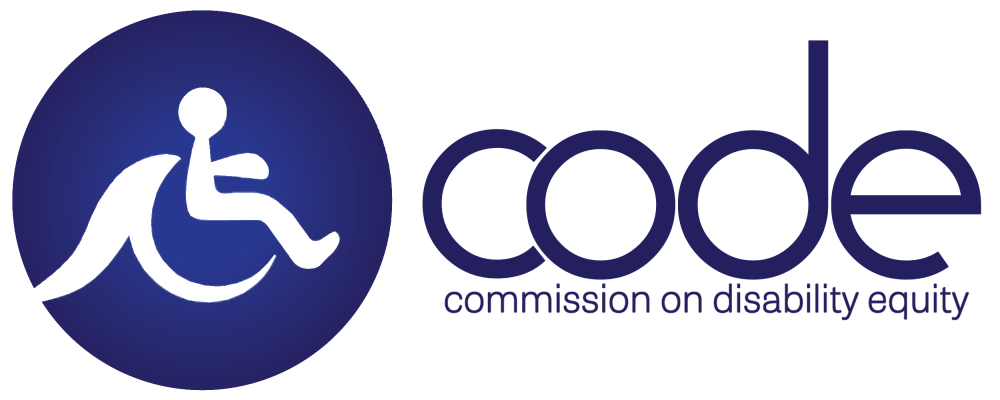Below, you can find some terms that our Commission often uses, as well as links to helpful resources if you would like to learn more about a particular term. You can find a more exhaustive list at Abolition and Disability Justice’s Glossary page. Be sure to check out our Disability Justice webpage if you would like to learn more about the principles that guide our organization’s work.
Ableism
Ableism is the intentional or unintentional discrimination or oppression of individuals with disabilities.
Use the embedded link to find Ashley Eisenmenger’s article, “Ableism 101: What it is, what it looks like, and what we can do to to fix it,” published on accessliving.org
For an in-depth look at how ableism shows up in everyday language, see Lydia X. Z. Brown’s post on ableist words and terms to avoid: https://www.autistichoya.com/p/ableist-words-and-terms-to-avoid.html
Access Need
An access need is something a person needs to communicate, learn, and take part in an activity. Many people have access needs.
Use the embedded link to find a resource guide from Pacific Alliance on Disability Self Advocacy (PADSA), that answers the questions, “What are access needs? What happens when those access needs don’t work together?”
Our Accessibility Guides page can help you find resources for making your organization or events more inclusive of people with diverse access needs.
Person/Identity-First Language
Person/Identity-first language is the use of “disabled person” or “disabled student.” This is different than person-first language, which uses terms like “person with a disability.”
Use the embedded link for a more detailed explanation of the language advocacy movements that have shaped the “portrayal of people with disabilities” from the Association of University Centers on Disabilities. They note, “If you are unsure as to whether you should use people-first or identity-first language in order to be respectful, the best thing to do is to ask people themselves.”
There are numerous perspectives on the use of “identity-first” language, versus “person-first” language. For example, the Autistic self-advocacy community and their allies largely prefer “identity-first” terminology; as Lydia X. Z. Brown describes, “autism” is a component of one’s identity that “defines the ways in which an individual experiences and understands the world around him or her.” Click the following link to find an article published on the “Autistic Self-Advocacy Network,” written by Lydia X. Z. Brown, which also includes links to other perspectives: https://autisticadvocacy.org/about-asan/identity-first-language/
Neurodiversity
Neurodiversity refers to the diversity of human minds, the infinite variation in neurocognitive functioning within our species.
See: this 60-second TikTok about Neurodiversity, and this 60-second TikTok that shares one perspective on “innate” and “acquired” neurodivergence. Both TikToks are captioned.
Neurocosmopolitanism.com: Neurodiversity: Some Basic Terms & Definitions provides extensive explanations of the following terms:
- neurodiversity
- neurodiversity paradigm
- Neurodiversity Movement
- neurodivergent/ND (and neurodivergence)
- neurotypical/NT
- neurominority
- neurodiverse
The Social Model of Disability
The social model of disability offers a framework for understanding “disabled” as a social identity.
This captioned 60-second TikTok, inspired by autistic researcher Dr. Jac den Houting (Tedx Talk,”Why everything you know about autism is wrong,” linked), gives a brief overview of the Social Model of Disability paradigm.
For more, see Lydia X. Z. Brown’s five-minute video breakdown of the social model of disability. [“Trigger warning: Mention of the Judge Rotenberg Center and brief description of the JRC’s practices, descriptions of forced medical procedures, sexual violence, and brief mentions of murder and hate crime. None of this is detailed, however.”] You can find a transcript of their presentation by clicking the following link: https://www.autistichoya.com/2013/03/constructing-disability-deviant-bodies.html
My Body Doesn’t Oppress Me, Society Does – In this captioned YouTube video, Patty Berne and Stacey Milbern present a social model of disability, explaining how universal design, adaptive devices, and meeting people’s access needs can limit the social, economic, and physical barriers that render physical impairments disabling in an ableist society. Milbern notes that focusing on individual impairments “lets society off the hook” for the structural oppression that renders some bodies and lives more valuable than others. Berne says “we are seen as disposable,” noting that the oppression that society ascribes to the individual body and disability is in fact a violent social construction.
SDQTBIPOC
This acronym stands for “Sick and Disabled Queer/Trans Black, Indigenous, and People of Color.
It is used to draw attention to the ways SDQTBIPOC communities are impacted by ableism in a variety of ways, as the Disability Justice framework highlights. For example, QTBIPOC specifically face barriers to treatment and care because of mistrust of the medical community, high uninsurance rates, among many other societal injustices, as this Human Rights Campaign resource guide on “QTBIPOC Mental Health and Well-Being” demonstrates: https://www.hrc.org/resources/qtbipoc-mental-health-and-well-being
Leah Lakshmi Piepzna-Samarasinha’s essay collection, Care Work: Dreaming Disability Justice, also uses the acronym SDQTBIPOC to talk about how working towards visions of a truly accessible and inclusive future must center the experiences of SDQTBIPOC. Resources for this book can be found on our “What is Disability Justice?” webpage. For a book review of “Care Work,” that talks about how SDQTBIPOC is used in the context of Piepzna-Samarasinha’s book, see the following link: https://www.tandfonline.com/doi/full/10.1080/09687599.2019.1648369#.YRBxpxyoPNY.link
Universal Design for Learning (UDL)
This is a framework for education that seeks to minimize barriers and maximize learning for all students.
This captioned YouTube video offers a brief overview of how UDL framework guides the design of instructional goals, assessments, methods, and materials that can be customized and adjusted to meet individual needs: https://www.youtube.com/watch?v=bDvKnY0g6e4&t=2s
For more information, click the following link: https://udlguidelines.cast.org/
